Overview of Thailand's Higher Education System
In Thailand, the higher education system is mainly under the Ministry of Education (MOE) and the Ministry of University Affairs (MUA). Other responsible ministries are Public Health, Agriculture and Cooperatives, Defenses, Transport and Communications, Justice, Science, Technology and the Environment, Office of the Prime Minister and the Thai Red Cross (Kirtikara, 2001).
Under the MOE, there are the Office of Vocational Education Commission (OVEC), the Office of the Higher Education Commission (OHEC) and the Office of the Basic Education Commission (OBEC) which is responsible for primary and secondary education. The OHEC is responsible for public universities, private higher education institutions (universities, colleges, and institutions), and community colleges. Moreover, it is also responsible for the national research universities’ projects. Their main objectives are to improve the quality of research at Thai universities and to promote Thai higher education. As national research universities, nine higher education institutions were recognized in 2009: Chiang Mai University; Chulalongkorn University; Kasetsart University; Khon Kaen University; King Mongkut’s University of Technology Thonburi; Mahidol University; Prince of Songkla University; Suranaree University of Technology; and Thammasat University (EP-Nuffic, 2015).
Higher education can be offered by universities, technical institutes, professional and technical colleges, and teachers’ colleges. There are two different types of institutions which can provide higher education. The first one is the institutions under the Ministry of Education, such as state universities and private institutions for higher education, technical/professional and agricultural institutions, and teacher training colleges while the second one is specialized training institutions under various ministries or government organizations (EP-Nuffic, 2015).
In 2000, 645 institutions were found in which different campuses were not counted. Out of these, there are 74 institutions under the MUA, 489 under MOE. 82 are the specialized institutions. For tertiary education, Diploma Level and Degree Level were offered. There are three programs namely academic, professional and technology programs (Kirtikara, 2001).
Based on the age-group, only one-fourth of the total are in higher education level although they should be at that level. This is because access to higher education is greatly different between regions. It may also vary on the socioeconomic conditions and concentration of schools and higher education institutes in Bangkok and big cities (Kirtikara, 2001).
After the Second World War, the public sectors played an important role in the institutes of higher education level. Nevertheless, during the last two decades, the government gave a permission to establish private colleges. Consequently, financial resources can be mobilized from the public as well as the private sector. The public sector contributes about 15 to 17% of total education budget to formal higher education although private or personal contribution to higher education cannot be estimated all together (Kirtikara, 2001).
Among the Southeast Asian countries, the higher education institutes of Thailand spread evenly across the whole country except for two provinces. The increased demand of the higher education can be met by the wide spread of higher education institutes, in depth involvement of the private sector in higher education, and judicious applications of information technology. Moreover, the contributions of organizations at the city and province levels and municipalities in the higher education can make the financial support for higher education as well as the direct funding of the central government (Kirtikara, 2001).
The office of higher education commission (2014) stated that there are 155 higher education institutions currently. Among them, 80 public higher education institutions consisting of 20 autonomous universities, 12 traditional universities, 39 Rajabhat Universities (formerly teacher training colleges), and 9 Rajamangala Universities of Technology, together with 74 private higher education institutions, and Office of Community College Administration. Over 2.2 million students are enrolled in higher education.
The higher education system has been reformed systematically since the end of 1980s which covered 1990 to 2004 (Kirtikara, 2001). The present educational system is designed after several reformats. Recently, the educational reform including the National Education Plan covering 2002 to 2016 started with the National Education Act in 1999 (EP-Nuffic, 2015).
The higher education policy in Thailand is to produce and develop the qualified candidates from the universities. And then, they are employed after their school years into the labor market as well as to build up the capacity of higher education compared with other countries in terms of knowledge and innovation. Moreover, the policy was to set up to collaborate the higher education institutions at both public and private sectors based on academic autonomy, diversity, and unity. Finally, it will lead to develop the whole society in a sustainable manner.
Agricultural Education at Higher Level
Agriculture which accounts for 50% of the country’s core economy. According to the national policy, it also plays a role in the social and economic development. The quality education in agricultre sector is the major concern for the development of the agriculture sector in the future (Falvey, 2000).
There are 74 public universities in Thailand in 2005. Twenty-four of them offered agricultural sciences. Traimongkolkul and Tanpichai (2005) reported that there were some limitations in agriculture at higher education level. The student enrollment for agricultural programs decreased because of less interest in the conventional agricultural sciences. Moreover, the number of dropout students increased every year. To deliver agriculture and its related programs, the professional resource persons had declined in the universities due to their retirement. There is also a weak linkage between the colleges of agriculture and ministry of agriculture which is responsible for research and extension.
Trends of Students for Undergraduate Level in Agriculture Sector in Kasetsart Universtiy
In the undergraduate level, programs were offered from different faculties as regular term and special term. There are 25 programs in the regular term under agriculture sector while eight programs are in the special term. From 2010 to 2016, the students enrolled in the programs of agrochemicals, pest management, home economics, agricultural sciences and food nutrition in the regular term. The trends of student enrollment in the regular term are shown in Fig. 1. Within seven years, there were no significantly differences in the enrollment trends in those five programs except for the agricultural sciences. The number of enrollment under the agricultural sciences program was the highest among those five programs (Fig. 1).
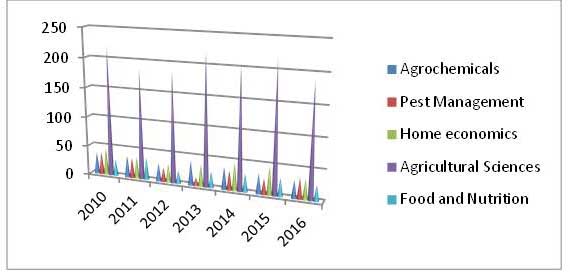
Fig. 1. Trends of enrollment in regular term from 2010-2016
Among the eight programs of special term, the students enrolled in the programs of tropical agriculture and international tropical agriculture (Figure 2). In 2010 and 2012, the students enrolled in tropical agriculture program while in international agriculture program in 2011 and 2014, 2015 and 2016. In 2013, there was no any special program under agriculture.
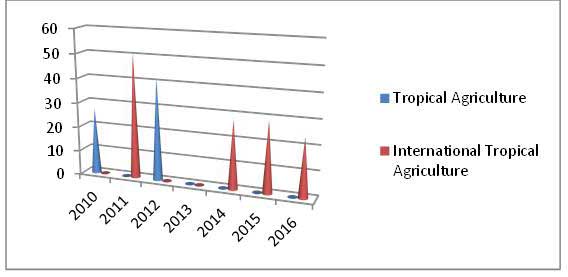
Fig. 2. Trends of enrollment in special term from 2010-2016
Trends of Students for Graduate Level in Agriculture Sector in Kasetsart Universtiy
In the graduate level, there are 16 programs for master students under agriculture. According to the ten years educational history (2004-2014), the agricultural extension program (for executives) started in 2005-06 academic year. The number of students steadily increased until 2009-10 and slightly decreased in 2010-11 and 2011-12. During the ten academic years, the enrollment for the agricultural extension program decreased in 2009-10 and 2010-11. And then, it sharply increased in 2011-12 and 2012-13 and slightly decreased in 2013-2014. There were no students enrolled in those two programs for doctoral degree (Figure 3).
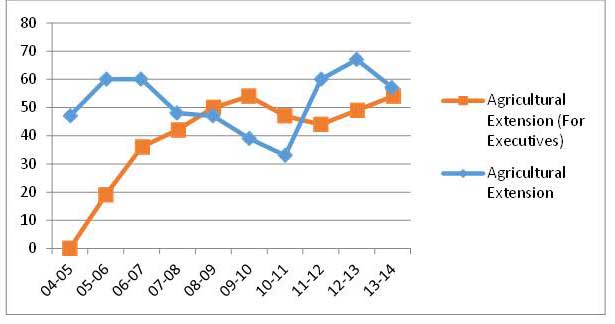
Fig.3. Trends of enrollment in Agriculrual Extension and Agricultural Extension (Executives) programs
In the entomology program, the number of students increased every year. However. it decreased during 2008-2011. After that, it increased to some extent. The international program for entomology was opened only two years in 2004-05 and 2005-06 and there was also only two students. As a contrast, there were students enrolled in the plant pathology program in all academic years and the number of students increased steadily (Fig. 4).
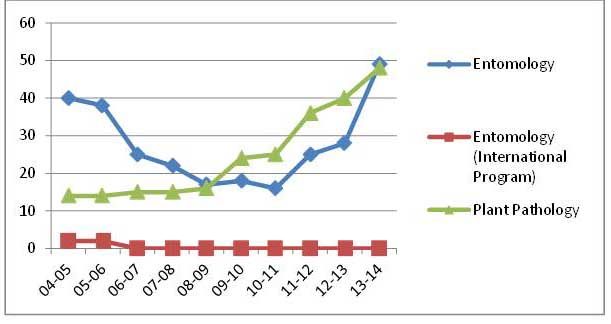
Fig. 4. Trends of enrollment in Entomology, Entomology (International Program) and Plant Pathology
The enrollment for home economics program decreased every year for 10 academic years. In 2011-12, the special program for home economics was opened in 2004-05 and the number of students was the highest in 2007-08 and then it fell down to about 58% (Fig. 5).
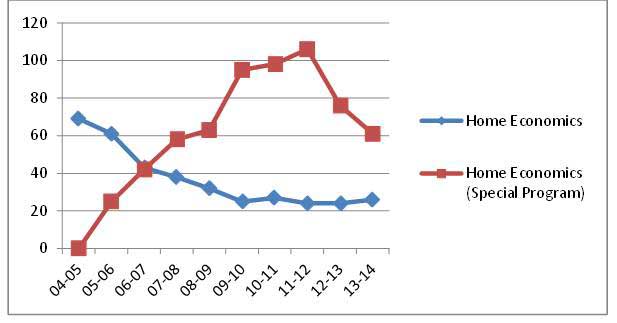
Fig. 5. Trends of enrollment in Home Economics and Home Economics (Special Program) programs
There was a variation in the enrollment for tropical agriculture (international program) within 10 academic years. The number of students was the highest in 2008-09 whereas the lowest in 2013-14. The special program of tropical agriculture was opened in 2005-06. There were few students for that program according to the record of ten academic year. Only one student enrolled for that program in each academic year of 2005-06 and 2008-09. The sustainable agriculture (international program) started in 2011-12. Agricultural systems technology program was offered in 2010-11 and the enrollment gradually increased in each academic year. (Fig. 6).
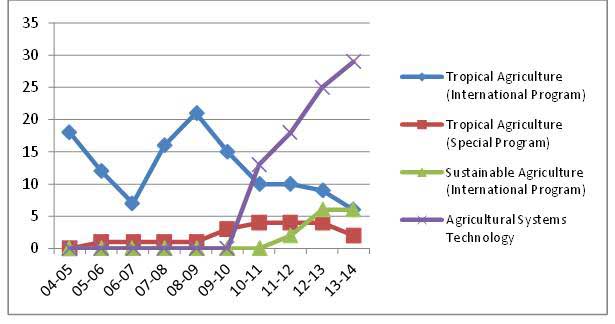
Fig. 6. Trends of enrollment in Tropical Agricultlure (International Program and Special Program), Sustainable Agriculture (International Program) programs and Agricultural Systems Technology
Fig. 7 showed the trends of enrollment in agronomy, animal science, development comunication (international program), horticulture and soil science. The enrollment in development comunication (international program) significantly declined within 10 academic years.
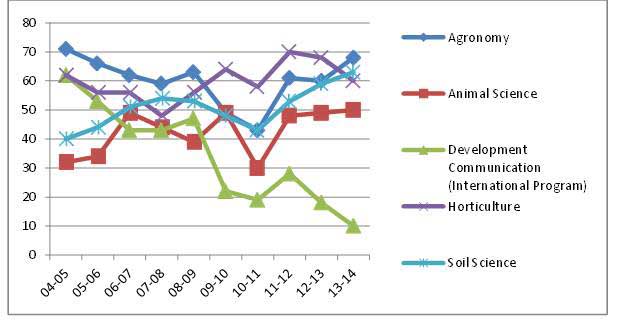
Fig. 7. Trends of enrollment in Agronomy, Animal Science, Development Comunication (International Program), Horticulture and Soil Science programs
There were eight programs for doctoral degree under agriculture. Among all programs, the highest enrollment was found in tropical agriculture (international program). However, there was a variation of student number in that program within ten academic years. In 2010-11, the enrollment was the highest while the lowest in 2006-07. The special program for tropical agriculture was opened in 2005-06 and the number of enrolled students gradually increased within nine years. The enrollment gradually increased in plant pathology while there were few variations in other programs in the enrollment (Fig. 8).

Fig. 8. Trends of enrollment in Agronomy, Animal Science, Entomology, Horticulture, Plant Pathology, Tropical Agriculture (International Program and Special Program) and Soil Science programs
Conclusion
The Office of Higher Education Commission (OHEC), one of the main offices under Ministry of Education (MOE), is responsible for public universities, private higher education institutions (universities, colleges, and institutions), and community colleges. Higher Education was mainly offered by institutions under MOE and the institutions under various ministries or government organizations. The increased demand for higher education to spread across the whole country can be met by the contribution of private sectors and improvement of information technology. Likewise, the burden of finance for higher education can be reduced through the involvement of organizations at city and provincial levels and municipalities. At current time, there are 80 public higher education and 74 private higher education institutions and office of community college administration. The enrollment in higher education are over 2.2 million. The higher education system has been reformed for several times to increase the development of the higher education. Since 50% of the country’s economy relies on agricultural production and its related industries. Therefore, agricultural education is the grass root for development of the agricultural sector by producing graduates who develop and produce technology and apply these in the real world.
References
EP-Nuffic. (2015). The Thai education system described and compared with the Dutch system. Education system Thailand | EP-Nuffic | 2nd edition February 2011 | version 3, January 2015. Retrieved on September 15, 2016 from https://www.epnuffic.nl/en/publications/find-a-publication/education-system-thailand.pdf
Falvey, L. (2000). Thai agriculture: Golden cradle of millennia. Bangkok: Kasetsart University Press.
Kirtikara, K. (2001). Higher education in Thailand and the National Reform Roadmap. Invited Paper presented at the Thai-US Education Roundtable, 9.
Office of the Higher Education Commission (OHEC). (2014). Thai Higher Education: Priorities and Key Development. The Office of the Higher Education Commission, Thailand. Retrieved on September 15, 2016 from http://inter.mua.go.th/higher-education-policies/
Traimongkolkul, P. and Tanpichai, P. (2005). Lessons Learned and Present Prospects: A Critical Review of Agricultural Education in Thailand. DOI: 10.5191/jiaee.2005.12305. Journal of International Agricultural and Extension Education. Volume 12. Retrieved on August 24, 2016 from https://www.aiaee.org/attachments/article/309/Traimongkolkul%2012.3-5.pdf
|
Date submitted: Dec. 6, 2016
Reviewed, edited and uploaded: Dec. 6, 2016
|


Thailand’s Higher Education System and the Agriculture Sector
Overview of Thailand's Higher Education System
In Thailand, the higher education system is mainly under the Ministry of Education (MOE) and the Ministry of University Affairs (MUA). Other responsible ministries are Public Health, Agriculture and Cooperatives, Defenses, Transport and Communications, Justice, Science, Technology and the Environment, Office of the Prime Minister and the Thai Red Cross (Kirtikara, 2001).
Under the MOE, there are the Office of Vocational Education Commission (OVEC), the Office of the Higher Education Commission (OHEC) and the Office of the Basic Education Commission (OBEC) which is responsible for primary and secondary education. The OHEC is responsible for public universities, private higher education institutions (universities, colleges, and institutions), and community colleges. Moreover, it is also responsible for the national research universities’ projects. Their main objectives are to improve the quality of research at Thai universities and to promote Thai higher education. As national research universities, nine higher education institutions were recognized in 2009: Chiang Mai University; Chulalongkorn University; Kasetsart University; Khon Kaen University; King Mongkut’s University of Technology Thonburi; Mahidol University; Prince of Songkla University; Suranaree University of Technology; and Thammasat University (EP-Nuffic, 2015).
Higher education can be offered by universities, technical institutes, professional and technical colleges, and teachers’ colleges. There are two different types of institutions which can provide higher education. The first one is the institutions under the Ministry of Education, such as state universities and private institutions for higher education, technical/professional and agricultural institutions, and teacher training colleges while the second one is specialized training institutions under various ministries or government organizations (EP-Nuffic, 2015).
In 2000, 645 institutions were found in which different campuses were not counted. Out of these, there are 74 institutions under the MUA, 489 under MOE. 82 are the specialized institutions. For tertiary education, Diploma Level and Degree Level were offered. There are three programs namely academic, professional and technology programs (Kirtikara, 2001).
Based on the age-group, only one-fourth of the total are in higher education level although they should be at that level. This is because access to higher education is greatly different between regions. It may also vary on the socioeconomic conditions and concentration of schools and higher education institutes in Bangkok and big cities (Kirtikara, 2001).
After the Second World War, the public sectors played an important role in the institutes of higher education level. Nevertheless, during the last two decades, the government gave a permission to establish private colleges. Consequently, financial resources can be mobilized from the public as well as the private sector. The public sector contributes about 15 to 17% of total education budget to formal higher education although private or personal contribution to higher education cannot be estimated all together (Kirtikara, 2001).
Among the Southeast Asian countries, the higher education institutes of Thailand spread evenly across the whole country except for two provinces. The increased demand of the higher education can be met by the wide spread of higher education institutes, in depth involvement of the private sector in higher education, and judicious applications of information technology. Moreover, the contributions of organizations at the city and province levels and municipalities in the higher education can make the financial support for higher education as well as the direct funding of the central government (Kirtikara, 2001).
The office of higher education commission (2014) stated that there are 155 higher education institutions currently. Among them, 80 public higher education institutions consisting of 20 autonomous universities, 12 traditional universities, 39 Rajabhat Universities (formerly teacher training colleges), and 9 Rajamangala Universities of Technology, together with 74 private higher education institutions, and Office of Community College Administration. Over 2.2 million students are enrolled in higher education.
The higher education system has been reformed systematically since the end of 1980s which covered 1990 to 2004 (Kirtikara, 2001). The present educational system is designed after several reformats. Recently, the educational reform including the National Education Plan covering 2002 to 2016 started with the National Education Act in 1999 (EP-Nuffic, 2015).
The higher education policy in Thailand is to produce and develop the qualified candidates from the universities. And then, they are employed after their school years into the labor market as well as to build up the capacity of higher education compared with other countries in terms of knowledge and innovation. Moreover, the policy was to set up to collaborate the higher education institutions at both public and private sectors based on academic autonomy, diversity, and unity. Finally, it will lead to develop the whole society in a sustainable manner.
Agricultural Education at Higher Level
Agriculture which accounts for 50% of the country’s core economy. According to the national policy, it also plays a role in the social and economic development. The quality education in agricultre sector is the major concern for the development of the agriculture sector in the future (Falvey, 2000).
There are 74 public universities in Thailand in 2005. Twenty-four of them offered agricultural sciences. Traimongkolkul and Tanpichai (2005) reported that there were some limitations in agriculture at higher education level. The student enrollment for agricultural programs decreased because of less interest in the conventional agricultural sciences. Moreover, the number of dropout students increased every year. To deliver agriculture and its related programs, the professional resource persons had declined in the universities due to their retirement. There is also a weak linkage between the colleges of agriculture and ministry of agriculture which is responsible for research and extension.
Trends of Students for Undergraduate Level in Agriculture Sector in Kasetsart Universtiy
In the undergraduate level, programs were offered from different faculties as regular term and special term. There are 25 programs in the regular term under agriculture sector while eight programs are in the special term. From 2010 to 2016, the students enrolled in the programs of agrochemicals, pest management, home economics, agricultural sciences and food nutrition in the regular term. The trends of student enrollment in the regular term are shown in Fig. 1. Within seven years, there were no significantly differences in the enrollment trends in those five programs except for the agricultural sciences. The number of enrollment under the agricultural sciences program was the highest among those five programs (Fig. 1).
Fig. 1. Trends of enrollment in regular term from 2010-2016
Among the eight programs of special term, the students enrolled in the programs of tropical agriculture and international tropical agriculture (Figure 2). In 2010 and 2012, the students enrolled in tropical agriculture program while in international agriculture program in 2011 and 2014, 2015 and 2016. In 2013, there was no any special program under agriculture.
Fig. 2. Trends of enrollment in special term from 2010-2016
Trends of Students for Graduate Level in Agriculture Sector in Kasetsart Universtiy
In the graduate level, there are 16 programs for master students under agriculture. According to the ten years educational history (2004-2014), the agricultural extension program (for executives) started in 2005-06 academic year. The number of students steadily increased until 2009-10 and slightly decreased in 2010-11 and 2011-12. During the ten academic years, the enrollment for the agricultural extension program decreased in 2009-10 and 2010-11. And then, it sharply increased in 2011-12 and 2012-13 and slightly decreased in 2013-2014. There were no students enrolled in those two programs for doctoral degree (Figure 3).
Fig.3. Trends of enrollment in Agriculrual Extension and Agricultural Extension (Executives) programs
In the entomology program, the number of students increased every year. However. it decreased during 2008-2011. After that, it increased to some extent. The international program for entomology was opened only two years in 2004-05 and 2005-06 and there was also only two students. As a contrast, there were students enrolled in the plant pathology program in all academic years and the number of students increased steadily (Fig. 4).
Fig. 4. Trends of enrollment in Entomology, Entomology (International Program) and Plant Pathology
The enrollment for home economics program decreased every year for 10 academic years. In 2011-12, the special program for home economics was opened in 2004-05 and the number of students was the highest in 2007-08 and then it fell down to about 58% (Fig. 5).
Fig. 5. Trends of enrollment in Home Economics and Home Economics (Special Program) programs
There was a variation in the enrollment for tropical agriculture (international program) within 10 academic years. The number of students was the highest in 2008-09 whereas the lowest in 2013-14. The special program of tropical agriculture was opened in 2005-06. There were few students for that program according to the record of ten academic year. Only one student enrolled for that program in each academic year of 2005-06 and 2008-09. The sustainable agriculture (international program) started in 2011-12. Agricultural systems technology program was offered in 2010-11 and the enrollment gradually increased in each academic year. (Fig. 6).
Fig. 6. Trends of enrollment in Tropical Agricultlure (International Program and Special Program), Sustainable Agriculture (International Program) programs and Agricultural Systems Technology
Fig. 7 showed the trends of enrollment in agronomy, animal science, development comunication (international program), horticulture and soil science. The enrollment in development comunication (international program) significantly declined within 10 academic years.
Fig. 7. Trends of enrollment in Agronomy, Animal Science, Development Comunication (International Program), Horticulture and Soil Science programs
There were eight programs for doctoral degree under agriculture. Among all programs, the highest enrollment was found in tropical agriculture (international program). However, there was a variation of student number in that program within ten academic years. In 2010-11, the enrollment was the highest while the lowest in 2006-07. The special program for tropical agriculture was opened in 2005-06 and the number of enrolled students gradually increased within nine years. The enrollment gradually increased in plant pathology while there were few variations in other programs in the enrollment (Fig. 8).
Fig. 8. Trends of enrollment in Agronomy, Animal Science, Entomology, Horticulture, Plant Pathology, Tropical Agriculture (International Program and Special Program) and Soil Science programs
Conclusion
The Office of Higher Education Commission (OHEC), one of the main offices under Ministry of Education (MOE), is responsible for public universities, private higher education institutions (universities, colleges, and institutions), and community colleges. Higher Education was mainly offered by institutions under MOE and the institutions under various ministries or government organizations. The increased demand for higher education to spread across the whole country can be met by the contribution of private sectors and improvement of information technology. Likewise, the burden of finance for higher education can be reduced through the involvement of organizations at city and provincial levels and municipalities. At current time, there are 80 public higher education and 74 private higher education institutions and office of community college administration. The enrollment in higher education are over 2.2 million. The higher education system has been reformed for several times to increase the development of the higher education. Since 50% of the country’s economy relies on agricultural production and its related industries. Therefore, agricultural education is the grass root for development of the agricultural sector by producing graduates who develop and produce technology and apply these in the real world.
References
EP-Nuffic. (2015). The Thai education system described and compared with the Dutch system. Education system Thailand | EP-Nuffic | 2nd edition February 2011 | version 3, January 2015. Retrieved on September 15, 2016 from https://www.epnuffic.nl/en/publications/find-a-publication/education-system-thailand.pdf
Falvey, L. (2000). Thai agriculture: Golden cradle of millennia. Bangkok: Kasetsart University Press.
Kirtikara, K. (2001). Higher education in Thailand and the National Reform Roadmap. Invited Paper presented at the Thai-US Education Roundtable, 9.
Office of the Higher Education Commission (OHEC). (2014). Thai Higher Education: Priorities and Key Development. The Office of the Higher Education Commission, Thailand. Retrieved on September 15, 2016 from http://inter.mua.go.th/higher-education-policies/
Traimongkolkul, P. and Tanpichai, P. (2005). Lessons Learned and Present Prospects: A Critical Review of Agricultural Education in Thailand. DOI: 10.5191/jiaee.2005.12305. Journal of International Agricultural and Extension Education. Volume 12. Retrieved on August 24, 2016 from https://www.aiaee.org/attachments/article/309/Traimongkolkul%2012.3-5.pdf
Date submitted: Dec. 6, 2016
Reviewed, edited and uploaded: Dec. 6, 2016